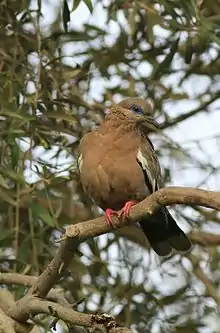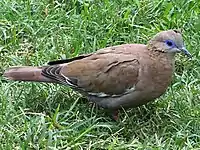West Peruvian dove
The West Peruvian dove or Pacific dove (Zenaida meloda) was first described in 1843 by the Swiss naturalist Johann Jakob Baron von Tschudi. It is closely related to the North American white-winged dove (Zenaida asiatica), but is now considered a separate species by ornithologists due to genetic and behavioral differences.[2] Specimens are brownish-gray above and gray below, with a bold white wing patch that appears as a brilliant white crescent in flight and is also visible at rest. Adults have a bright blue (almost indigo), featherless patch of skin around each eye. The legs and feet of adults are red, but unlike Z. asiatica, their eyes are brown. Both sexes are similar, but juveniles have a lighter color than adults, they do not have blue eye rings, and their legs and feet are brownish-pink.
| |||||||||||||||||||||||||||||||||
| Cladogram showing the position of the West Peruvian dove in the genus Zenaida.[3] |
| West Peruvian dove | |
|---|---|
 | |
| In Lima, Peru | |
| Scientific classification | |
| Kingdom: | Animalia |
| Phylum: | Chordata |
| Class: | Aves |
| Order: | Columbiformes |
| Family: | Columbidae |
| Genus: | Zenaida |
| Species: | Z. meloda |
| Binomial name | |
| Zenaida meloda (Tschudi, 1843) | |
Major habitats
- 1.5 Forest – Subtropical/Tropical Dry
- 1.6 Forest – Subtropical/Tropical Moist
- 11.6 Subtropical/Tropical Heavily Degraded Former Forest.[1]
Range
Its native range extends along the Pacific coastal plains from southern Ecuador to northern Chile. Contrary to unscientific internet sources, the species is not found on San Andrés. This species has a large range, with an estimated global extent of occurrence of 187,000 km2. Its global population has not been estimated, but may be large, as the species is described as "common" in at least parts of its range. Global population trends have not been quantified, but the species is not believed to approach the thresholds for the population decline criterion of the IUCN Red List (i.e. declining more than 30% in 10 years or three generations). For these reasons, the species is evaluated as least concern.[1]
Trivia
This dove's cooing calls have earned it the name cuculí in Peru, from the dove's syncopated cooing, transcribed as coo-coo-LEE.
References
- BirdLife International (2012). "Zenaida meloda". IUCN Red List of Threatened Species. 2012. Retrieved 26 November 2013.CS1 maint: ref=harv (link)
- Johnson, Kevin P. & Clayton, Dale H. (2000). "A Molecular Phylogeny of the Dove Genus Zenaida: Mitochondrial and Nuclear DNA sequences" (PDF). Condor. 102 (4): 864–870. doi:10.1650/0010-5422(2000)102[0864:ampotd]2.0.co;2.
- Banks, R.C.; Weckstein, J.D.; Remsen Jr, J.V.; Johnson, K.P. (2013). "Classification of a clade of New World doves (Columbidae: Zenaidini)". Zootaxa. 3669 (2): 184–188. doi:10.11646/zootaxa.3669.2.11.


